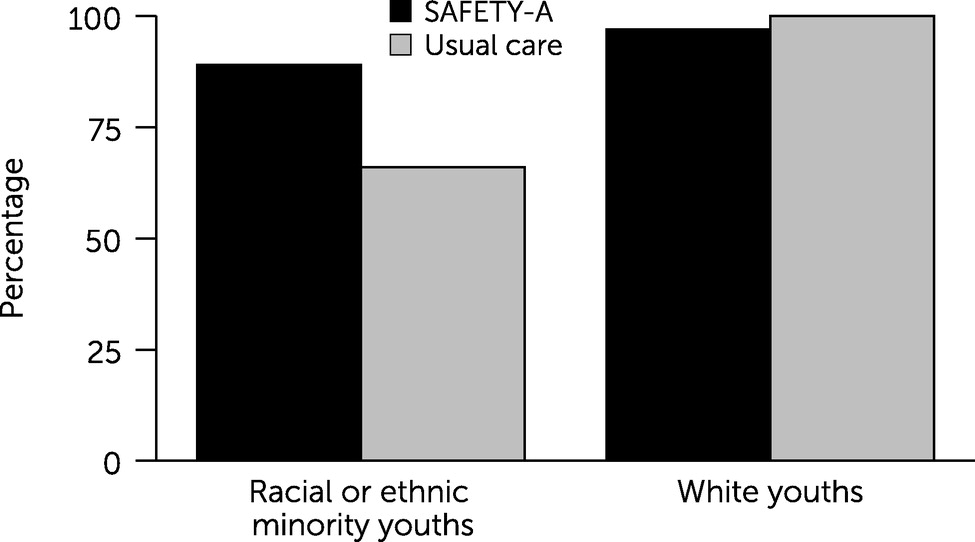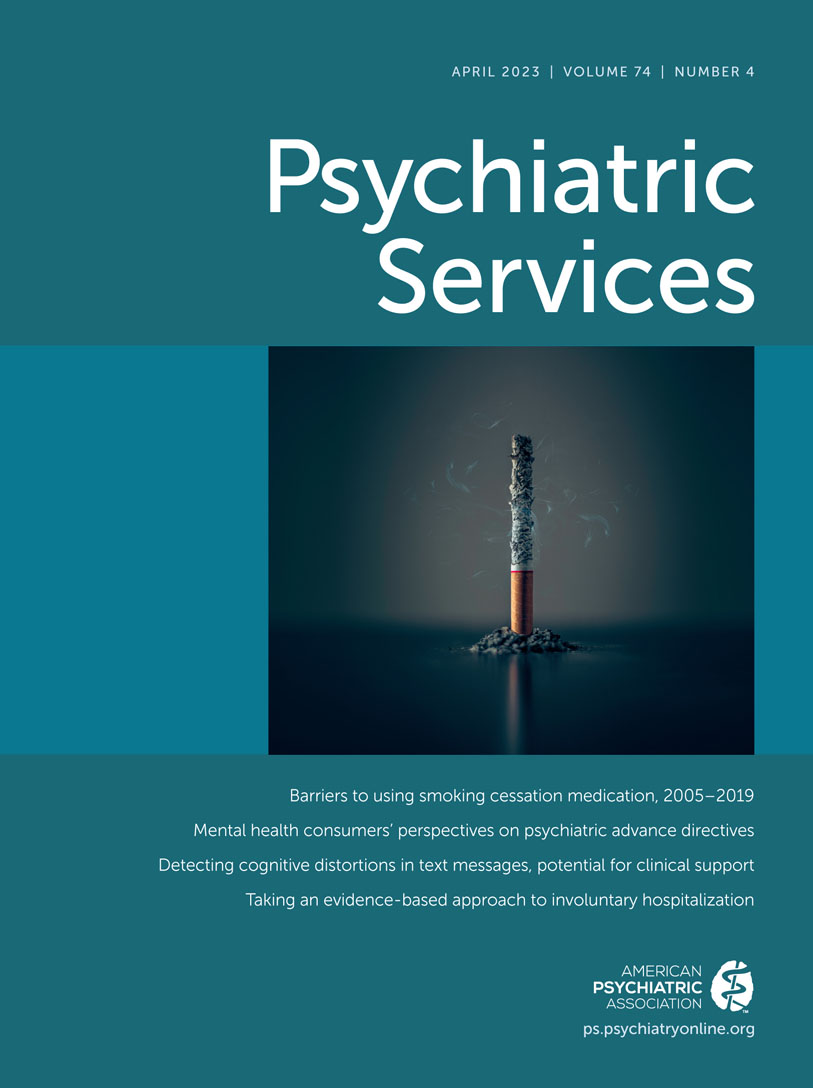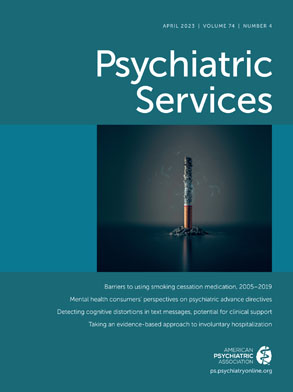Many youths who receive emergency department (ED) treatment for episodes of suicidal ideation or behavior do not receive follow-up mental health treatment, with rates of aftercare ranging from 43% to 66% (
1,
2). Accordingly, the U.S. National Strategy for Suicide Prevention lists increasing continuity of care after a suicidal episode as a major objective (
3). Racial-ethnic minority youths are disproportionately affected by ruptures in care continuity, which are shaped by systemic barriers, including institutional racism, disparate access to care coverage and specialty services, and lack of culturally responsive care (
4). Recent data have indicated that rates of suicide attempt are higher among Black (12%) and Latinx (9%) youths than among White youths (8%) (
5). Suicide attempts among Black adolescents increased 73% from 1991 to 2017 (
6), and the rate of suicide deaths has increased among Black and Latinx youths (
7). Evidence suggests that racial-ethnic minority youths may disproportionately benefit from evidence-based treatments (EBTs) targeting depression and suicidal ideation and behavior (
8). EBTs linking at-risk youths with mental health care have the potential to reduce disparities in critical public health outcomes.
Two authors of this article (M.S.B. and J.R.A.) led the development of an ED-based mental health intervention, originally known as the Family Intervention for Suicide Prevention and subsequently renamed Safe Alternatives for Teens and Youths–Acute (SAFETY-A) (
9,
10), for youths who have had an episode of suicidal ideation or behavior. Results from a randomized controlled trial (RCT) demonstrated that receiving SAFETY-A resulted in improved rates of aftercare (92%) compared with usual care enhanced with provider education (76%) (
9). SAFETY-A is a strengths-based, cognitive-behavioral family approach to enhancing youth safety. Intervention components provide a caring, culturally sensitive, and supportive strengths-based approach, engaging youths, parents, and families to enhance youth safety and cultivating positive therapeutic interactions to support engagement in crucial post-ED aftercare services (
9,
10). This approach has the potential to allay mistrust and mitigate stigma, two factors that inhibit engagement with mental health care (
11). Given enduring medical mistrust, linked to historical abuses, among racial-ethnic minority communities, SAFETY-A has the potential to enhance care equity for racial-ethnic minority youths in ways that have not been thoroughly investigated. In this brief report, we evaluate SAFETY-A’s effects among racial-ethnic minority youths, emphasizing mental health treatment linkage after ED or hospital discharge, which was the parent study’s prespecified primary service use outcome (
9). We predicted that SAFETY-A would yield higher rates of aftercare treatment linkage among racial-ethnic minority youths than enhanced usual care. Although multiple factors influence the amount of treatment received, we also examined SAFETY-A’s effects on the dose of post-ED treatment.
Methods
All procedures were approved by the institutional review boards of the participating sites. RCT procedures to compare SAFETY-A with enhanced usual care are described in detail elsewhere (
9). The racial-ethnic minority sample consisted of 105 patients, ages 10–18 years, who had an episode of suicidal ideation or behavior between April 2003 and August 2005 and were treated at one of two EDs in Los Angeles. Of the youths, 69% (N=72) identified as Hispanic or Latinx, 18% (N=19) as Black or African American, 11% (N=11) as Asian American, and 3% (N=3) as “other.”
After a brief baseline assessment, youths were randomly assigned within each ED to receive SAFETY-A or usual care enhanced with provider education about suicide risk evaluation and management. More detail on the SAFETY-A and control conditions is provided in previous publications (
9,
10). SAFETY-A included a brief ED-based youth and family crisis therapy session and follow-up contacts to enhance linkage to follow-up care. The ED crisis therapy session focused on identifying youth and family strengths, cultivating understanding of emotional reactions with an “emotional thermometer,” using this information to develop and practice a safety plan designed to prioritize safety should suicidal or unsafe emotional reactions emerge, enhancing motivation to continue treatment, troubleshooting treatment barriers, and counseling families on lethal means restriction and disinhibition associated with substance use. Approximately 2 months after ED discharge, assessors naïve to randomization status administered follow-up assessments to youths and parents.
Spanish-speaking therapists were available to deliver SAFETY-A to monolingual Spanish-speaking families; intervention materials included culturally appropriate examples; and therapist training and supervision took into account cultural values, expectations, and context.
The Service Assessment for Children and Adolescents, adapted slightly for ED patients (
12), was administered to youths and parents and yielded the following outcome measures: linkage to outpatient treatment (a dichotomous variable indicating whether youths received any outpatient mental health aftercare) and outpatient psychotherapy treatment dose (a dichotomous variable distinguishing an inadequate treatment dose [one to five sessions] from an adequate dose [six or more sessions]). As in previous research, attending six or more sessions was deemed “probable appropriate treatment” (
12). Consistent with our previous publications, we used parent reports when available and substituted youth data when they were not (
9,
12). Sensitivity analyses conducted using youth reports as the primary data source yielded no substantive differences.
With complete data for baseline assessments and limited nonresponse to follow-up assessments, our analysis strategy involved supplementing unadjusted outcome comparisons with analyses adjusted for baseline covariates, which showed an imbalance (p<0.20) between those who did and those who did not provide follow-up assessments. We also adjusted analyses for baseline covariates known to be predictive of study outcomes. For the primary hypothesis that compared SAFETY-A with usual care with respect to treatment linkage, we performed a chi-square test encompassing all racial-ethnic minority youths, as well as separate tests in the two predominant racial-ethnic minority subgroups (Black and Latinx). We also performed covariate-adjusted Firth logistic regression analyses, which use a penalized-likelihood framework to avoid small-sample bias and convergence failures and have the effect of smoothing predicted probabilities toward 0.5. In parallel analyses, we examined intervention effects on adequate treatment dose among those who were linked to follow-up services. Descriptive summaries for White participants (N=55) within the same randomized controlled trial were produced for comparison.
Results
We used t tests and chi-square tests to compare baseline covariate distributions between those who provided follow-up assessments (87%, N=105 of 121) and those who did not (13%, N=16 of 121). Attrition was significantly greater among male youths than among female youths (27%, N=8 of 30, vs. 9%, N=8 of 91, respectively; p=0.012), with no significant differences for other covariates (age, ED site, hospitalization after ED discharge).
Results revealed significantly greater effectiveness of SAFETY-A compared with usual care, with higher rates of treatment linkage among racial-ethnic minority youths receiving SAFETY-A (89%, N=42 of 47) than among those receiving usual care (66%, N=38 of 58; OR=4.11, 95% CI=1.46–11.61, p=0.008) (
Figure 1). In the covariate-adjusted analysis, hospitalization predicted higher treatment linkage (p=0.004), gender did not predict treatment linkage, and the data suggested that youths receiving treatment at the county ED (which serves a greater proportion of low-income, racial-ethnic minority, and uninsured or publicly insured patients) were less likely to receive linkage to follow-up care. The inference favoring SAFETY-A over usual care remained significant after adjustment for covariates.
For Latinx youths, who made up most of the racial-ethnic minority sample (69%), we found a significant intervention effect on treatment linkage (SAFETY-A, 97% [N=29 of 30]; usual care, 62% [N=26 of 42]; p=0.001). For Black youths, the second largest subgroup (18%), the linkage rate was higher among those receiving SAFETY-A, but the intervention advantage was not statistically significant (SAFETY-A, 80% [N=8 of 10]; usual care, 67% [N=6 of 9]).
SAFETY-A did not significantly predict receipt of an adequate treatment dose among racial-ethnic minority youths who were linked to aftercare. Among those engaging in follow-up treatment, the overall rate of patients receiving six or more aftercare therapy sessions (22%, N=17 of 76) did not differ significantly across intervention arms (SAFETY-A, 21% [N=8 of 39]; usual care, 24% [N=9 of 37]).
Nearly all White study participants initiated aftercare treatment, yielding a nonsignificant intervention effect on treatment linkage (SAFETY-A, 97% [N=28 of 29]; usual care, 100% [N=26 of 26]). With near-complete linkage, no significant covariate effects could be ascertained. Analyses of aftercare treatment dose for White youths revealed a significant advantage to receiving SAFETY-A compared with enhanced usual care (SAFETY-A, 54% [N=15 of 28]; usual care, 27% [N=7 of 26]; p=0.046), with a higher percentage of patients in the SAFETY-A group receiving an adequate dose.
Discussion
Racial-ethnic minority youths receiving SAFETY-A were more likely to initiate mental health treatment after ED or hospital discharge relative to those receiving enhanced usual care. This effect held across EDs and regardless of whether youths were hospitalized after ED discharge. The greater effectiveness of SAFETY-A compared with usual care demonstrates that a culturally sensitive, developmentally informed safety planning intervention can improve care continuity after ED or hospital discharge among racial-ethnic minority youths receiving ED treatment for an episode of suicidal ideation or behavior, a requisite step for fulfilling the national suicide prevention objective of delivering effective treatment after ED or hospital visits (
3). Although ED infrastructures may need adaptation to implement SAFETY-A, results from recent ED quality improvement initiatives support SAFETY-A’s feasibility and acceptability, with more youths considered safe for discharge home when SAFETY-A was used as an intervention and behavioral risk assessment (
13,
14).
Despite SAFETY-A’s effectiveness in linking racial-ethnic minority youths to care, SAFETY-A and usual care were associated with similar rates of receiving at least six treatment sessions, a proxy indicator for adequate treatment dose. Although SAFETY-A has promise for improving treatment linkage after ED or hospital discharge for racial-ethnic minority youths, additional support through
promotoras, care navigators, or care managers may be needed to support retention in care after linkage (
8). Such approaches are needed to augment interventions such as SAFETY-A and to enhance equity across the care continuum. Moreover, the nature of follow-up treatment may be a more potent predictor of long-term suicide attempt outcomes, consistent with findings that the combination of SAFETY-A and evidence-informed follow-up treatment resulted in reduced risk of suicide attempt over time (
15). Similarly, dialectical behavior therapy, an efficacious EBT for reducing youth suicide attempts, has particularly strong effects with Latinx youths and is associated with increased treatment dose (
16,
17). These data underscore the importance of retention in effective follow-up treatment as a key quality-of-care indicator relevant to the advancement of racial equity.
Our results also illustrate that nearly all White youths were linked to aftercare, regardless of intervention condition, but that those who received SAFETY-A were more likely to receive an adequate treatment dose than those who received enhanced usual care. Thus, SAFETY-A also has positive effects for White youths, who were already likely to access longer-term care that meets their needs. In contrast, SAFETY-A does not appear sufficient to address longer-term care needs of racial-ethnic minority youths. Future research is needed to determine whether this enduring racial disparity can be attributed to routine care for racial-ethnic minority youths being of low quality or unresponsive to the cultural needs of racial-ethnic minority youths. Last, subgroup analyses indicated that receiving SAFETY-A, compared with receiving usual care, led to statistically significantly greater treatment linkage for Latinx youths, who made up most of our sample. Although effects were in the same direction for Black youths, the findings were not statistically significant in this small subsample, highlighting the need for additional research with Black youths.
This study had limitations. Our sample was collected 17 to 19 years ago and consisted of primarily Latinx youths drawn from two EDs in one geographic region. Research evaluating SAFETY-A in larger, more diverse samples is needed. Despite near-perfect prediction of treatment linkage for White youths, nearly all of whom received aftercare across groups, the study was not powered to evaluate interaction effects. We performed analyses on complete cases, with attention to covariate imbalances, and incorporated available information on relationships between predictors and outcomes without aiming to estimate population means or proportions. Although interpretations are tempered by methodological constraints, this study provides meaningful directions for future research on suicide prevention and related disparities.
Conclusions
The need to address premature deaths, injuries, and dysfunctions associated with youth suicidality remains urgent in racial-ethnic minority communities, particularly given alarming increases in suicide risk among Black and Latinx youths (
7). Racial-ethnic disparities in treatment receipt and quality of follow-up care continue (
4), resulting in calls for expanded efforts to remedy inequities in evidence-based suicide prevention. This study underscores SAFETY-A’s potential to improve mental health equity by increasing rates of post-ED aftercare linkage among racial-ethnic minority youths who have had episodes of suicidal ideation or behavior. Future work should prioritize suicide prevention strategies that help racial-ethnic minority youths transition from ED care to aftercare and stay in treatment long enough to obtain an effective treatment dose. More broadly, a joint focus on immediate and longer-term care after episodes of suicidal ideation or behavior can help address disparities in mental health outcomes.
Acknowledgments
The authors thank the youths, families, staff, and colleagues who made this project possible.


